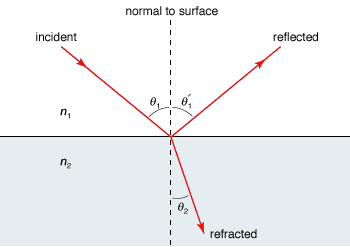Light Waves
Light can be
described as an electromagnetic wave, with frequencies
ranging from 4 x 1014 Hz to 8 x 1014
Hz, and also as a particle. For this web page we will only
be talking about the wavelike nature of light.Light waves are a convenient way to examine electromagnetic waves because these waves are visible and act similar to other electromagnetic waves when coming in contact with a medium. All electromagnetic waves can releft and can refract when coming in contact with a medium.
 |
| https://d2gne97vdumgn3.cloudfront.net/api/file/uYgeYVv2QgmN2KEcmJyC |
 |
| https://www.math.ubc.ca/~cass/courses/m309-01a/chu/Fundamentals/snell01.gif |
 |
| https://qph.ec.quoracdn.net/main-qimg-b817b59c40c597b12f3d8237d121a83f |
The fact that we can see is because of these light waves. What we see is actually the reflection of light off of a surface. When a light wave comes in contact with an object, lets say a red apple, the apple actually absorbs all the colors that are not red. So what we are seeing when looking at the apple is actually the red waves reflected back into our eyes. Our brain can then interperate these waves entering our eyes as an image.
 |
| http://www.univie.ac.at/geographie/fachdidaktik/FD/site/external_htmls/imagers.gsfc.nasa.gov/ems/visible.gif |